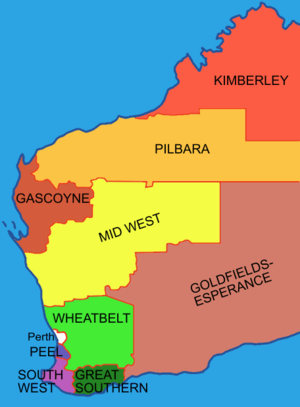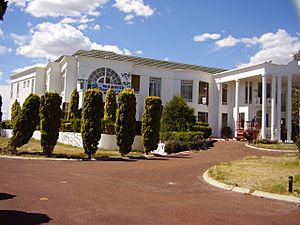Lang Hancock facts for kids
Quick facts for kids
Lang Hancock
|
|
|---|---|
| Born |
Langley Frederick George Hancock
10 June 1909 |
| Died | 27 March 1992 (aged 82) Prix D'Amour, Mosman Park, Western Australia
|
| Occupation | Mining magnate |
| Known for | Discovery of the world's largest iron deposit; Western Australian secessionism; other business and mining interests |
| Board member of | Hancock Prospecting Pty Ltd |
| Spouse(s) |
Susette Maley
(m. 1935; div. 1944)Hope Nicholas Clark
(m. 1947; wid. 1983)Rose Lacson
(m. 1985; wid. 1992) |
| Children | Gina Rinehart |
Langley Frederick George "Lang" Hancock (born 10 June 1909 – died 27 March 1992) was an Australian mining leader from Western Australia. He was well-known in business and politics. He became famous for finding the world's largest iron ore deposit in 1952. This discovery made him one of Australia's richest people. He is also remembered for his marriage to Rose Porteous, a woman from the Philippines who used to be his maid. His daughter, Gina Rinehart, did not approve of this marriage. The disagreements between Gina and Rose continued for many years, even after Lang's death.
Besides his public personal life, Hancock had strong views on the Australian government and other social topics. These views sometimes caused debate during his lifetime.
Contents
Early Life and Family
Lang Hancock was born on 10 June 1909, in Leederville, Perth, Western Australia. He was the oldest of four children. His family owned a large farm, called a "station," at Ashburton Downs. Later, they moved to Mulga Downs Station in the north-west.
Lang first learned at home. When he was eight, he went to a boarding school in Toodyay, Western Australia. From 1924 to 1927, he attended Hale School in Perth. After school, he went back to Mulga Downs Station to help his father manage the property.
In 1935, Lang married Susette Maley. They lived at Mulga Downs for many years. Lang also took over managing the station from his father that same year. He worked with his old school friend, E. A. "Peter" Wright, to run the property. They had a strong partnership based on trust.
During World War II, Lang served in a local defense group. On 4 August 1947, he married his second wife, Hope Margaret Nicholas. She was the mother of his only known child, Gina Rinehart. Lang and Hope were married for 35 years until she passed away in 1983.
Mining Asbestos at Wittenoom
As a child, Lang Hancock was very interested in mining. When he was ten, he found asbestos at Wittenoom Gorge. In 1934, he officially claimed the area. He started mining blue asbestos there in 1938 with a company called Australian Blue Asbestos.
A larger company, CSR Limited, bought his claim in 1943. Lang kept a 49% share in the business. However, he felt his opinions were not valued. So, he sold his remaining share in 1948. The mine later became known for health problems related to asbestos.
Discovering Iron Ore
On 16 November 1952, Lang Hancock said he found the world's biggest iron ore deposit. This was in the Pilbara region of Western Australia. He explained that he was flying with his wife, Hope, when bad weather forced them to fly low. They flew through the gorges of the Turner River, where he saw the iron ore.
This story is widely believed today. Lang returned to the area many times. With another prospector, Ken McCamey, he tracked the iron ore for a long distance.
For a decade, Lang worked hard to get a ban on iron ore exports lifted. In 1961, he was finally able to announce his discovery. He could then officially claim the land.
In the mid-1960s, Lang partnered again with Peter Wright. They made a deal with the mining company Rio Tinto Group to develop the iron ore find. Lang named the area "Hope Downs" after his wife. As part of the deal, Rio Tinto set up a mine there. Lang and Peter received annual payments, called royalties, which were split between them. By 1990, Lang Hancock was estimated to be worth at least A$125 million.
Political Views and Actions
Lang Hancock never wanted to be a politician himself. However, he had strong conservative political views. He often got involved in political discussions. He gave a lot of money to politicians from different parties. His views were most similar to the Liberal and National parties.
He was a good friend and supporter of Queensland Premier Joh Bjelke-Petersen. He gave a lot of money to the Queensland National Party. He also gave money to the Western Australian Labor Party, saying they "can't do any harm." Lang had disagreements with the Western Australian Liberals.
In 1969, Lang and Peter Wright started a weekly newspaper in Perth. It was called The Sunday Independent. They hoped it would help their mining interests. The newspaper faced tough competition and likely never made a profit.
Lang believed in a small government. He disliked what he saw as the national government interfering in Western Australian matters. In 1991, he stated, "I have always believed that the best government is the least government." He felt that governments could be "disruptive and destructive" to business.
Lang also supported a group that wanted Western Australia to become a separate country. In 1979, he published a book called Wake Up Australia. It explained why he thought Western Australia should separate.
Marriage to Rose Porteous
In 1983, after his second wife Hope passed away, Rose Lacson (now Porteous) came to Australia from the Philippines. Lang's daughter, Gina Rinehart, arranged for Rose to work as a maid for Lang.
Lang and Rose became romantically involved. They got married on 6 July 1985, in Sydney. It was the third marriage for both of them. Rose was 39 years younger than Lang. Lang's daughter, Gina, did not attend the wedding.
Lang was very fond of Rose early in their marriage. He gave her money and invested in real estate for her. Rose helped Lang feel younger. She updated his clothes, dyed his hair, and helped him stop using his cane. Together, they built a very large mansion called "Prix d'Amour." It had 16 blocks of land and overlooked the Swan River. The mansion was inspired by the house from the movie Gone with the Wind. They held many big parties there.
As time went on, their relationship became difficult. Despite their arguments, Lang and Rose remained married until Lang's death in 1992.
The Prix d'Amour, built in 1990, was torn down in March 2006.
Death and Investigation
Lang Hancock passed away in March 1992, at 82 years old. He was living in the guesthouse of Prix D'Amour. An autopsy showed he died of natural heart disease. Police found nothing to suggest otherwise.
However, Lang's daughter believed that his wife, Rose, had caused his death. After several requests, an official investigation, called an inquest, was finally held in 1999.
The inquest began in April 2001. It focused on claims that Rose had stressed Lang with arguments. Rose denied these claims. She famously said, "For anyone else it would be a tantrum, for me it's just raising my voice." The inquest concluded that Lang Hancock died of natural causes. It found that his death was not caused by Rose's behavior.
Legacy
Lang Hancock's daughter, Gina Rinehart, continues to lead Hancock Prospecting. The company keeps expanding its mining projects in Western Australia and other parts of Australia. In 2011, it was estimated to earn about A$870 million in revenue.
Gina Rinehart has become Australia's richest person. For a time in 2012, she was also the world's richest woman.
The Hancock Range, located about 65 kilometers north-west of Newman, is named after the family. It honors their important role in starting the farming and mining industries in the Pilbara region.
|



